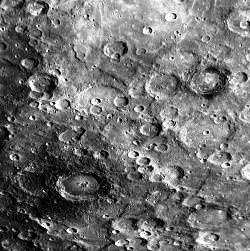
Mercury’s craters are also throwing up questions about the evolution of this barren world. The 3.8 billion year old Caloris basin marks the site of a huge impact event, which Mariner 10 was only able to image part of. The new images show that the size of this basin had previously been underestimated by about 250km, making its revised diameter a massive 1550km. Inside Caloris, seemingly emanating from its centre, is a rather unusual collection of around 100 narrow trough-like features. Serendipitously placed at the bullseye is a 40+km wide crater. The combination of the crater and the outward propagating troughs have resulted in its being nicknamed ‘the spider’ (picture), whose origin is a subject of much debate.
David Rothery is the Chief Scientist on the Mercury Imaging X-ray Spectrometer (MIXS), which will fly on a future mission to Mercury, Bepi-Colombo. He believes that the crater that sits more-or-less centrally on the spider pattern marks an impact post-dating the formation of the radial features. “It has a clear central peak and some slumping of its inner wall, as expected for a crater of this size” he says. “A complication is a somewhat sinuous graben-like (flat floored) valley that cuts across the finer spider texture south of the crater; but I think this is older than the crater too. My guess is that the radial pattern is related to isostatic rebound of the central part of the Caloris basin.”
Some of the other craters observed by MESSENGER also have intriguing features. Some have apparently darkened crater rims and incomplete ‘haloes’ of darker material immediately surrounding their rims (picture). The team working on these haloes has two possible explanations: either darker material was excavated from beneath the crater during the impact event, or some of the surface material may have melted during impact, splashing across the surface. Craters that exhibit these halos are relatively young, which supports the notion that that Mercury’s surface processes have not yet had time to reduce their contrast.
These recent images offer just a taste of what is to come and two more previews are planned for October 2008 and September 2009 before MESSENGER goes into orbit around Mercury in March 2011. MESSENGER will be followed by the launch of the European Space Agency’s Bepi-Columbo mission in 2012. The next 10 years will be an exciting time for scientists interested in understanding the evolution of a planet residing so close to its parent star.
- Images: NASA/Johns Hopkins University Applied Physics Laboratory/Carnegie Institution of Washington.